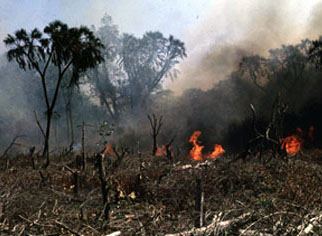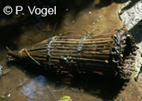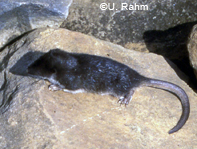Afrotherian Conservation


Slash and burn agriculture in an Afrotherian HOTspot: Gedi Ruins "National Park", Kenya 1972. Photos by G. Rathbun
The species listed here are classified on the IUCN redlist as either endangered (EN), vulnerable (VU), or near-threatened (NT) by the 2016 IUCN RedList. While some of the IUCN categories do not necessarily imply imminent extinction, the trend in many cases is negative. That is, without additional effort towards conservation on the part of local communities, NGOs, national and international regulatory agencies, "first world" consumers, and other relevant parties, these species will eventually become extinct, many within your lifetime.
Here are PDF file downloads of conservation fact sheets for the Aardvark, Golden Moles, Sengis, Tenrecs, and Hyraxes. These fact sheets are periodically updated, and they supersede Nicoll, M. E. and G. B. Rathbun. 1990. African Insectivora and Elephant-shrews, an action plan for their conservation. International Union for Conservation of Nature and Natural Resources (IUCN), Gland, Switzerland.
In many cases, the causes of extinction are simple: destruction of natural habitat due to increased exploitation of fossil fuels, timber, minerals, and expansion of agricultural zones by humans.
Human population is increasing exponentially and, in many places, we are consuming per capita an ever increasing share of the Earth's resources. No one knows exactly what the carrying capacity of the planet is for any single species. However, the consequences of exceeding that capacity will be truly dire, at least for humans.
Small, at-risk afrotherians on the 2016 IUCN Red List of Threatened Species
Tenrecidae: at least 8 of ca. 34 species are at risk |

 Micropotamogale lamottei with bownet used by locals for fishing. The bownet frequently traps and kills Micropotamogale. Photos by P. Vogel |

Micropotamogale ruwenzorii. |
Chrysochloridae: at least 12 of 21 species are at risk |
Chrysochloridae, |
Macroscelididae: at least 3 of 19 species are at risk |
Afrotherian "Hotspots"
- Nimba mountains, Liberia, Ivory Coast, Guinea (home to Micropotamogale lamottei)
- Namaqualand coastal plain, Succulent Karoo biome, South Africa (home to Eremitalpa granti, Cryptochloris wintoni, and Cryptochloris zyli)
- Rwenzori Mountains, Rwanda, Congo (home to Micropotamogale ruwenzorii)
- Andekaleka, Madagascar (home to Limnogale mergulus)
- Ranomafana National Park, Madagascar (home to many species of Microgale and Limnogale)
- Arabuko-Sokoke Forest, Kenya (home to Rhynchocyon chrysopygus)
- High-altitude grasslands of South Africa, with five endemic golden mole taxa (Chrysospalax villosus, Chlorotalpa sclateri, Amblysomus robustus, Amblysomus septentrionalis, and two subspecies of Amblysomus hottentotus).
- Pretoria, South Africa (home to one of only 3 known populations of Neamblysomus julianae, and formerly to Chrysospalax villosus, now thought to be locally extinct)
- Soutpansberg Mountains, South Africa (home to Neamblysomus gunningi)
- Udzungwa Mountains, Tanzania (home of R. udzungwensis)
Small afrotherians possibly at risk of extinction, but without adequate information for assessment
Chrysochloridae |
Tenrecidae |
Macroscelididae |
Non-Governmental Conservation Groups Helping to Protect Afrotherian Habitat
- The EDGE program of the Zoological Society of London draws attention to the large number of species that face imminent extinction, including small afrotherians such as the golden rumped sengi and Nimba otter shrew.
- The Madagascar Ankizy Fund was started by a paleontological team from Stony Brook University to improve access to health care and education facilities for villagers in remote areas of Madagascar. A healthy and educated local human population will, in the long term, benefit the Malagasy fauna (including afrotherians such as the Tenrecidae).
- A Rocha Kenya aims to achieve long-term conservation of threatened habitats and species in the Arabuko-Sokoke Forest.
- The Tanzania Forest Conservation Group (TFCG) is actively supporting the conservation of Tanzania's coastal and Eastern Arc forests through a combination of protected area management, community development, environmental education, advocacy and research. With over 20 years experience, TFCG is Tanzania's leading national non-governmental organization addressing the conservation of Tanzania's high biodiversity forests (including a focus on coastal forests).
- WWF Tanzania's coastal forest programme is supporting the conservation of forests along Tanzania's coastal zone. WWF is active in Muheza, Rufiji and Kilwa Districts. WWF TPO is also supporting the conservation of the Udzungwa Mountains National Park in the Eastern Arc Mountains. WWF - East African Regional Programme Office supports an ecoregion programme addressing the conservation of the East African coastal forests. The programme links initiatives in Tanzania, Kenya and Mozambique.
- Critical Ecosystem Partnership Fund provides strategic assistance to civil society organizations to help safeguard Earth's biodiversity hotspots, the biologically richest and most threatened areas. CEPF has invested US$ 7 million in the conservation of the Eastern Arc and Coastal Forests of Kenya and Tanzania.
- Tanzania Natural Resources Forum is a collective civil society-based initiative to improve natural resource management in Tanzania by addressing fundamental issues of natural resource governance.
- TRAFFIC South / Eastern Africa actively monitors and investigates wildlife and endangered species trade and provides information gathered as a basis for effective conservation policies and actions. TRAFFIC have played an important role in highlighting governance shortfalls in the Tanzanian Forestry sector by providing detailed information on the scale of illegal logging in Tanzania's coastal forests. This information has stimulated renewed efforts to improve the governance of Tanzania's forests.
- The Mpingo Conservation Project aims to conserve endangered forests in East Africa by promoting sustainable and socially equitable harvesting of mpingo and other valuable timber stocks. The Mpingo Conservation Project is active in Kilwa District in Tanzania.
- The Eastern Arc Mountains Conservation Endowment Fund (EAMCEF) is a Trust Fund that was established as a mechanism to provide for long term, reliable and sustainable funding support to biodiversity conservation in the Eastern Arc Mountains of Tanzania.
Conservation Groups of General Interest
- World Wildlife Fund
- Fauna and Flora International
- The Sierra Club
- Zoological Society of London
- Cambridge Conservation Forum
- Tropical Biology Association
- Population Connection (formerly Zero Population Growth)
- Optimum Population Trust
- Rettet den Regenwald (Save the Rainforest)